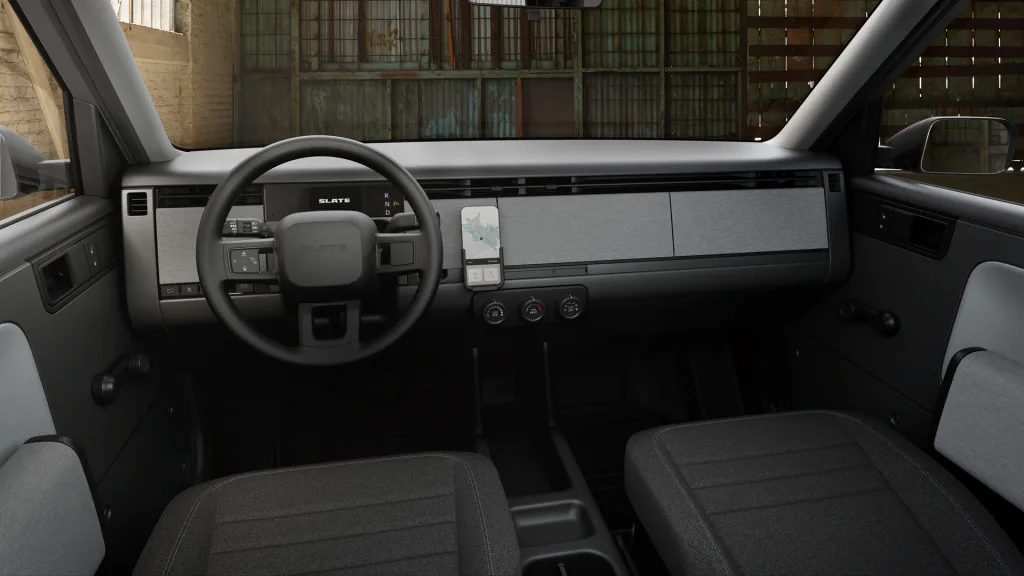This company wants its $20K EV to help boost adoption. Will there be enough charging stations to keep up?
Last month in Los Angeles electric vehicle startup Slate Auto revealed its low-cost, American-made electric truck, with hopes to become the holy grail the auto industry needs to make EVs more affordable and accessible.The company expects its trucks’ sales price to be less than $20,000 with $7,500 U.S. federal tax incentives taken into consideration. While markets like Europe and China are seeing moderate to accelerated sales growth in their electric vehicle markets, the transition to EVs is slower in the United States. According to McKinsey’s latest annual survey, 12% of respondents in the U.S. said they intend their next car purchase to be a battery electric vehicle. However, the rate of EV adoption depends on where consumers are located in the country with urban areas seeing rates twice as much as rural areas. That data may indicate that adoption rates in the U.S. will remain slow, but Slate Auto chief commercial officer Jeremy Snyder is hoping the company can build demand by focusing on accessibility. “Slate is approaching the automobile differently,” Snyder says. “We are not competing with the existing market so I think it is creating a new one. People are going to want this one for the price, for the personalization.” According to the company, Slate Auto has raised its Series A and Series B, amounting to almost $700 million in funding. The company plans to produce up to 150,000 vehicles annually by the end of 2027—which would be less than 10% of Tesla’s 2024 deliveries, but roughly three times what luxe EV brand Rivian expects to deliver this year. [Image: Slate] Less Money, more problems? Currently, the average transaction price of an electric car in the U.S. is $59,205. Much of the market is dominated by high-dollar makers like Tesla, Rivian, and Polestar, which are likely out of reach for hourly wage workers—Slate Auto’s target audience. “When you talk about target demographics for current automotive, everybody is going towards the top 20%, 30% of the market,” Snyder says. “We don’t need to focus there. We need to focus [on] the folks that don’t have a lot of product choice. Those are the folks that we are really wanting to provide a safe, reliable, and affordable vehicle to.” Since its reveal event, a recent report indicates that the company has garnered over 100,000 refundable reservations ahead of the truck’s availability, which is expected by the last quarter of 2026. [Image: Slate] Infrastructure issues Though Slate’s early numbers suggest an appetite for low-cost EVs, that hints at a need for more robust charging infrastructure, according to Philipp Kampshoff, McKinsey senior partner and leader of the consultancy’s automotive practice. “ The moment you tap into the volume segment, you will also tap into a part of the consumer population that is going to be more reliant on public charging,” Kampshoff says. “Right now, most of the battery electric vehicle buyers are more affluent. They tend to have their own houses and they can charge at home. The moment you go more and more in the volume segment, [you] will have people that don’t own their houses and may be renting.” McKinsey’s summer 2024 report on EV buying trends, found only 9% of respondents felt existing charging infrastructure was sufficient. Kampshoff explains that particularly in the U.S., there is a “chicken and egg” problem when it comes to public charging infrastructure. Some consumers are hesitant to purchase an EV because public charging stations are either not visible or do not exist. On the other hand, charging infrastructure players may not want to invest in establishing charging stations because of low EV ownership. Based on lessons from other regions, potential solutions to this problem could center on government incentives beyond subsidies. For instance, in China, some nonmonetary incentives include preferential parking for EV drivers. Additionally, increasing awareness of existing public charging stations could also help resolve the issue. “When people are worried because there’s not enough charging infrastructure, you don’t take that worry away unless you know they see it,” Kampshoff says. “ If you’re driving down a highway, it’s very easy to see a gas station. But, there’s no signage for EV stations in most states.”

Last month in Los Angeles electric vehicle startup Slate Auto revealed its low-cost, American-made electric truck, with hopes to become the holy grail the auto industry needs to make EVs more affordable and accessible.The company expects its trucks’ sales price to be less than $20,000 with $7,500 U.S. federal tax incentives taken into consideration.
While markets like Europe and China are seeing moderate to accelerated sales growth in their electric vehicle markets, the transition to EVs is slower in the United States. According to McKinsey’s latest annual survey, 12% of respondents in the U.S. said they intend their next car purchase to be a battery electric vehicle. However, the rate of EV adoption depends on where consumers are located in the country with urban areas seeing rates twice as much as rural areas.
That data may indicate that adoption rates in the U.S. will remain slow, but Slate Auto chief commercial officer Jeremy Snyder is hoping the company can build demand by focusing on accessibility. “Slate is approaching the automobile differently,” Snyder says. “We are not competing with the existing market so I think it is creating a new one. People are going to want this one for the price, for the personalization.”
According to the company, Slate Auto has raised its Series A and Series B, amounting to almost $700 million in funding. The company plans to produce up to 150,000 vehicles annually by the end of 2027—which would be less than 10% of Tesla’s 2024 deliveries, but roughly three times what luxe EV brand Rivian expects to deliver this year.

Less Money, more problems?
Currently, the average transaction price of an electric car in the U.S. is $59,205. Much of the market is dominated by high-dollar makers like Tesla, Rivian, and Polestar, which are likely out of reach for hourly wage workers—Slate Auto’s target audience.
“When you talk about target demographics for current automotive, everybody is going towards the top 20%, 30% of the market,” Snyder says. “We don’t need to focus there. We need to focus [on] the folks that don’t have a lot of product choice. Those are the folks that we are really wanting to provide a safe, reliable, and affordable vehicle to.”
Since its reveal event, a recent report indicates that the company has garnered over 100,000 refundable reservations ahead of the truck’s availability, which is expected by the last quarter of 2026.

Infrastructure issues
Though Slate’s early numbers suggest an appetite for low-cost EVs, that hints at a need for more robust charging infrastructure, according to Philipp Kampshoff, McKinsey senior partner and leader of the consultancy’s automotive practice.
“ The moment you tap into the volume segment, you will also tap into a part of the consumer population that is going to be more reliant on public charging,” Kampshoff says. “Right now, most of the battery electric vehicle buyers are more affluent. They tend to have their own houses and they can charge at home. The moment you go more and more in the volume segment, [you] will have people that don’t own their houses and may be renting.”
McKinsey’s summer 2024 report on EV buying trends, found only 9% of respondents felt existing charging infrastructure was sufficient.
Kampshoff explains that particularly in the U.S., there is a “chicken and egg” problem when it comes to public charging infrastructure. Some consumers are hesitant to purchase an EV because public charging stations are either not visible or do not exist. On the other hand, charging infrastructure players may not want to invest in establishing charging stations because of low EV ownership.
Based on lessons from other regions, potential solutions to this problem could center on government incentives beyond subsidies. For instance, in China, some nonmonetary incentives include preferential parking for EV drivers. Additionally, increasing awareness of existing public charging stations could also help resolve the issue.
“When people are worried because there’s not enough charging infrastructure, you don’t take that worry away unless you know they see it,” Kampshoff says. “ If you’re driving down a highway, it’s very easy to see a gas station. But, there’s no signage for EV stations in most states.”





































































































































































































